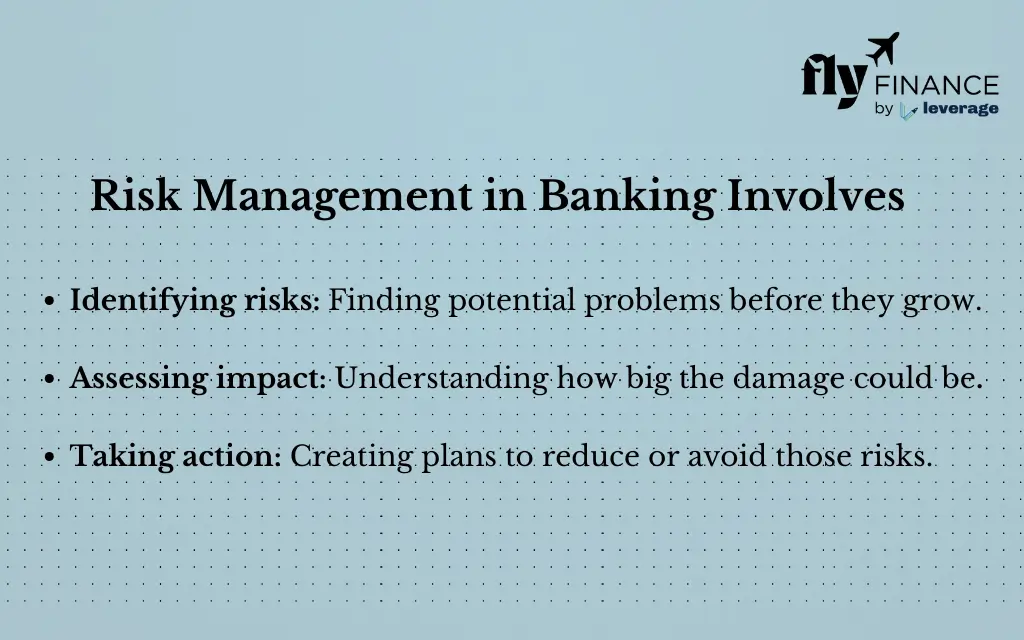Banking powers India’s economy, supporting everything from small businesses to massive industries. Yet, it’s not without challenges—loan defaults, fraud, and even natural disasters can shake things up. That’s why risk management in banking is so crucial—it keeps banks strong and reliable.
For Indian students eyeing a career in finance, this topic is a goldmine. It’s not just about numbers; it’s about protecting people’s money and building trust. Let’s dive into what risk management in banking is, why it matters, and how it shapes Ascendancy shapes India’s financial future.
Table of contents
- What Does Risk Management in Banking Mean?
- Why is Risk Management in Banking Important?
- Types of Risks in Indian Banking
- How do Banks Handle Risk Management?
- Role of Technology in Risk Management
- Why You Should Study Risk Management in Banking
- Career Opportunities in Risk Management
- FAQs on Risk Management in Banking
What Does Risk Management in Banking Mean?
Risk management in banking is all about spotting and handling risks that could harm a bank’s operations or its customers. These risks might include financial losses, fraud, or unexpected events like floods affecting branches and others. It’s a system that keeps banks and account holders money safe.
Top banks like SBI, PNB, HDFC and others rely on risk management to thrive in a competitive market. It’s a mix of sharp analysis and quick decision-making skills that can make you stand out in a banking career!
Here’s what risk management in banking involves:

Why is Risk Management in Banking Important?
All Banks handle money daily, making them vulnerable to threats like theft, economic slumps, or new regulations. Risk management in banking ensures they can weather these storms without crashing. Last year, the RBI reported a 12% jump in non-performing assets (NPAs)—bad loans—reaching INR 8.35 lakh crore due to economic stress.
Thanks to solid risk management, banks tackled this head-on, keeping the system stable. Risk management in banking also builds trust. When banks manage risks well, students and families feel secure saving or borrowing money, keeping India’s economy humming.
Also Read: How to Remove NPA from Education Loan? – Fly Finance
Types of Risks in Indian Banking
Banks face a variety of risks, and risk management in banking addresses them all. For students aiming for a finance career, knowing these risks is a must. Here are the big ones in India:
- Credit Risk: This risk arises when borrowers fail to repay loans or meet financial obligations. This is one of the most significant risks for banks, as non-performing assets directly impact profitability.
Example: If a borrower defaults on a home loan, the bank suffers a financial loss, which can accumulate over time if multiple borrowers fail to repay their loans.
- Market Risk: This refers to potential losses due to changes in financial markets, such as interest rates, stock prices and foreign exchange rates. Banks that engage in investment activities must carefully monitor market trends to mitigate risks.
Example: A sudden drop in interest rates can reduce the profitability of fixed-income investments held by a bank.
- Operational Risk: This risk arises due to internal failures, fraud, system breakdowns, or human errors. With increased digital banking services, cybersecurity threats have also become a major concern under operational risk.
Example: A cyber-attack on a bank’s online banking platform can lead to data breaches and financial losses.
- Liquidity Risk: This risk occurs when a bank is unable to meet its short-term financial obligations due to insufficient cash flow. Proper liquidity management is vital to ensure smooth banking operations.
Example: If a bank cannot provide cash withdrawals to customers due to poor liquidity management, it can lead to a crisis.
- Regulatory and Compliance Risk: Banks must adhere to legal and regulatory requirements set by institutions like the Reserve Bank of India (RBI). Failure to follow these regulations may result in penalties, reputational damage, and legal action.
Example: If a bank fails to maintain the required capital adequacy ratio, it may face restrictions from the RBI.
How do Banks Handle Risk Management?
All banks act quickly to manage their risks. For risk management in banking, they use clever tools and strategies that Indian students can master for a bright future. Here are some of the key strategies used by banks:
1. Credit Risk Management
- Conduct thorough credit analysis before approving loans.
- Monitor borrower creditworthiness regularly.
- Diversify loan portfolios to minimize exposure to high-risk borrowers.
2. Market Risk Management
- Use financial derivatives like futures and options to hedge risks.
- Diversify investment portfolios to balance risk and return.
- Continuously monitor market trends and economic indicators.
3. Operational Risk Management
- Implement robust internal controls and fraud detection systems.
- Invest in advanced cybersecurity measures.
- Train employees on risk awareness and fraud prevention.
4. Liquidity Risk Management
- Maintain sufficient cash reserves.
- Use stress testing to assess liquidity risk in adverse scenarios.
- Establish strong relationships with financial institutions for emergency funding.
5. Regulatory Compliance Management
- Regularly update compliance policies in line with RBI guidelines.
- Conduct periodic audits to ensure adherence to legal requirements.
- Use risk assessment tools to monitor regulatory risks proactively.
Also Read: Currency Exchange Risks: Know Foreign Exchange Risk
Role of Technology in Risk Management
Technology plays a vital role in modern risk management in banking practices. Banks are increasingly adopting artificial intelligence (AI), big data analytics, and blockchain technology to enhance their risk management processes.
1. Artificial Intelligence (AI): AI-powered algorithms analyze vast amounts of financial data to detect fraudulent transactions and predict market trends.
2. Big Data Analytics: Big data helps banks assess customer behavior, identify credit risks, and develop personalized financial products.
3. Blockchain Technology: Blockchain ensures secure and transparent financial transactions, reducing risks associated with fraud and data manipulation.
Why You Should Study Risk Management in Banking
India’s banking sector is growing, and so is the need for skilled pros. Risk management in banking offers a rewarding career for students who love problem-solving. Plus, you’ll help shape India’s financial future.
With digital banking like UPI soaring, risks like cyberattacks are rising too. A 2024 NASSCOM report predicts India’s fintech sector will need 1 million workers by 2030—many in risk roles. Here’s why it’s a win for you:
| Benefit | What It Means for Students |
| Job Growth | Tons of opportunities in banking and fintech. |
| Real Impact | Protect banks and customers from big losses. |
| Skill Boost | Learn analysis, tech, and decision-making skills. |
This is your chance to shine in a field that’s both secure and cutting-edge.
Career Opportunities in Risk Management
For Indian students, risk management in banking offers promising career paths in the banking and financial sector. Some key job roles in risk management include:
- Risk Analyst: Evaluates potential risks and develops strategies to mitigate them.
- Credit Risk Manager: Assesses borrowers’ creditworthiness and minimizes default risks.
- Operational Risk Consultant: Identifies internal vulnerabilities and ensures process efficiency.
- Compliance Officer: Ensures the bank adheres to regulatory requirements.
With growing financial complexities, the demand for risk management professionals is increasing. Best risk management courses like FRM (Financial Risk Manager) and CFA (Chartered Financial Analyst) can enhance career prospects in this field.
Risk management in banking is important for ensuring financial stability, regulatory compliance, and customer trust. Banks face multiple risks, including credit, market, operational, liquidity, and regulatory risks, which require robust risk management strategies. For Indian students aspiring to build a career in finance, understanding risk management is highly beneficial.
FAQs on Risk Management in Banking
Risk management in banking is the process of identifying, assessing, and controlling risks that could harm a bank’s operations or customers. It protects banks from financial losses, fraud, and unexpected events, ensuring stability and trust.
It helps banks handle threats like loan defaults and cyberattacks, keeping the financial system stable. For example, in 2023, solid risk management tackled a 12% rise in bad loans worth INR 8.35 lakh crore, as per RBI data.
The main types of risks in banking are credit risk (loan defaults), market risk (price fluctuations), operational risk (fraud or tech failures), liquidity risk (cash shortages), and regulatory risk (non-compliance with RBI rules).
Banks analyze borrowers’ creditworthiness, monitor loans regularly, and diversify their portfolios to reduce the impact of defaults, a key part of risk management in banking.
Tech like AI detects fraud, big data analyzes risks, and blockchain secures transactions. These tools help banks stay ahead of threats in today’s digital world.
Yes! With India’s fintech sector needing 1 million workers by 2030 (NASSCOM 2024), roles like risk analyst and compliance officer offer great opportunities for students.
It ensures that banks remain trustworthy, so students and families can safely save or borrow money, supporting India’s economic growth.
To learn more about bank accounts for students, the best education loans, forex, banking experience for global students, or international money transfers, reach out to our experts at 1800572126 to help ease your experience with studying abroad.
Follow Us on Social Media





























